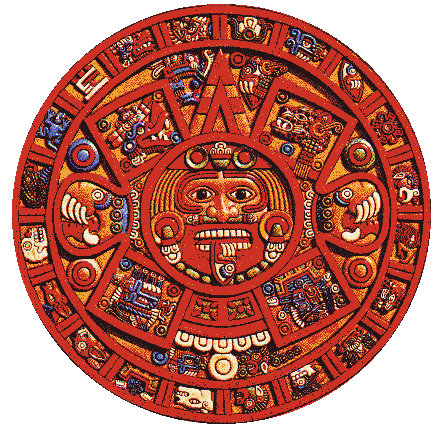Post by CIVILISON on Sept 20, 2005 20:48:16 GMT -5
www.valdostamuseum.org/hamsmith/2012.html
.
.
.
"... Terence McKenna ... suggests that the position of winter solstice sun within 3 degrees of the Galactic Center in the year 2012 A.D. (a "once-in-a-precessional- cycle" event) may provide the eschatological end point for his theory of time known as Timewave Zero. His end date was chosen for historical reasons and was, apparently, only later discovered to correspond with the Mayan end date. ... on winter solstice of 2012, Galactic Center will be rising heliacally just before dawn, in a way reminiscent of how the Maya observed Venus's last morningstar appearance. ...
... The Maya ... Classic Period is thought to have lasted from 200 A.D. to 900 A.D ... The early Maya adopted two different time keeping systems, the "Short Count" and the Long Count ...
... The Short Count derives from combining the tzolkin cycle with the solar year and the Venus cycle of 584 days. In this way, "short" periods of 13, 52 and 104 years are generated. ...
... The Long Count system ... is based upon nested cycles of days ...
* 1 [day] / Kin (day)
* 20 [days] / Uinal
* 360 [days] / Tun
* 7200 [days] / Katun
* 144000 [days] / Baktun
... For example: 6.19.19.0.0 equals 6 baktuns, 19 katuns, 19 tuns, 0 uinals and 0 days. If we add up all the values we find that 6.19.19.0.0 indicates a total of 1007640 days have elapsed since the Zero Date of 0.0.0.0.0.
The much discussed 13-baktun cycle is completed 1872000 days (13 baktuns) after 0.0.0.0.0. This period of time is the so called Mayan "Great Cycle" of the Long Count and equals 5125.36 years.
... The point of interest for these early astronomers seems to have been the projected end date in 2012 A.D., rather than the beginning date in 3114 B.C. Having determined the end date in 2012 (for reasons we will come to shortly), and calling it 13.0.0.0.0, they thus proclaimed themselves to be living in the 6th baktun of the Great Cycle. The later Maya certainly attributed much mythological significance to the beginning date, relating it to the birth of their deities, but it now seems certain that the placement of the Long Count hinges upon its calculated end point. ...".
.
.
.
... There is only one point in the entire cycle where ... the universe is actually evolving some kind of process of self-metamorphosis, and human beings indicate that we have crossed some boundary into some new era, a new epoch of ever greater acceleration into this process of self-revelation. ... that point occurs on this solstice date in 2012. ...".
PEACE!
.
.
.
"... Terence McKenna ... suggests that the position of winter solstice sun within 3 degrees of the Galactic Center in the year 2012 A.D. (a "once-in-a-precessional- cycle" event) may provide the eschatological end point for his theory of time known as Timewave Zero. His end date was chosen for historical reasons and was, apparently, only later discovered to correspond with the Mayan end date. ... on winter solstice of 2012, Galactic Center will be rising heliacally just before dawn, in a way reminiscent of how the Maya observed Venus's last morningstar appearance. ...
... The Maya ... Classic Period is thought to have lasted from 200 A.D. to 900 A.D ... The early Maya adopted two different time keeping systems, the "Short Count" and the Long Count ...
... The Short Count derives from combining the tzolkin cycle with the solar year and the Venus cycle of 584 days. In this way, "short" periods of 13, 52 and 104 years are generated. ...
... The Long Count system ... is based upon nested cycles of days ...
* 1 [day] / Kin (day)
* 20 [days] / Uinal
* 360 [days] / Tun
* 7200 [days] / Katun
* 144000 [days] / Baktun
... For example: 6.19.19.0.0 equals 6 baktuns, 19 katuns, 19 tuns, 0 uinals and 0 days. If we add up all the values we find that 6.19.19.0.0 indicates a total of 1007640 days have elapsed since the Zero Date of 0.0.0.0.0.
The much discussed 13-baktun cycle is completed 1872000 days (13 baktuns) after 0.0.0.0.0. This period of time is the so called Mayan "Great Cycle" of the Long Count and equals 5125.36 years.
... The point of interest for these early astronomers seems to have been the projected end date in 2012 A.D., rather than the beginning date in 3114 B.C. Having determined the end date in 2012 (for reasons we will come to shortly), and calling it 13.0.0.0.0, they thus proclaimed themselves to be living in the 6th baktun of the Great Cycle. The later Maya certainly attributed much mythological significance to the beginning date, relating it to the birth of their deities, but it now seems certain that the placement of the Long Count hinges upon its calculated end point. ...".
.
.
.
... There is only one point in the entire cycle where ... the universe is actually evolving some kind of process of self-metamorphosis, and human beings indicate that we have crossed some boundary into some new era, a new epoch of ever greater acceleration into this process of self-revelation. ... that point occurs on this solstice date in 2012. ...".
PEACE!




